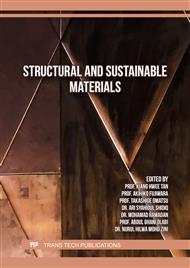[1]
J. Stavridis, A. Papacharalampopoulos, & P. Stavropoulos. (2018). Quality assessment in laser welding: a critical review. The International Journal of Advanced Manufacturing Technology, 94, 1825-1847.
DOI: 10.1007/s00170-017-0461-4
Google Scholar
[2]
T. W. Liao. (2009). Improving the accuracy of computer-aided radiographic weld inspection by feature selection. Ndt & E International, 42(4), 229-239.
DOI: 10.1016/j.ndteint.2008.11.002
Google Scholar
[3]
N. Nacereddine, A. B. Goumeidane & D. Ziou. (2019). Unsupervised weld defect classification in radiographic images using multivariate generalized Gaussian mixture model with exact computation of mean and shape parameters. Computers in Industry, 108, 132-149.
DOI: 10.1016/j.compind.2019.02.010
Google Scholar
[4]
X. Gao, N. Ma., & L. Du. (2018). Magneto-optical imaging characteristics of weld defects under alternating magnetic field excitation. Optics express, 26(8), 9972-9983.
DOI: 10.1364/oe.26.009972
Google Scholar
[5]
Z. Zhang, G. Wen., & S. Chen. (2017). Audible sound-based intelligent evaluation for aluminum alloy in robotic pulsed GTAW: mechanism, feature selection, and defect detection. IEEE Transactions on Industrial Informatics, 14(7), 2973-2983.
DOI: 10.1109/tii.2017.2775218
Google Scholar
[6]
Yusof. Kamaruzaman. M.F. M, M. A., M. Zubair, & M. Ishak. (2016). Detection of defects on weld bead through the wavelet analysis of the acquired arc sound signal. Journal of Mechanical Engineering and Sciences, 10(2), 2031-2042.
Google Scholar
[7]
N. Lv., Y. Xu., S. Li, X. Yu, & S. Chen. (2017). Automated control of welding penetration based on audio sensing technology. Journal of Materials Processing Technology, 250, 81-98.
DOI: 10.1016/j.jmatprotec.2017.07.005
Google Scholar
[8]
D. Naso, B. Turchiano, & P. Pantaleo. (2005). A fuzzy-logic based optical sensor for online weld defect-detection. IEEE transactions on Industrial Informatics, 1(4), 259-273.
DOI: 10.1109/tii.2005.857617
Google Scholar
[9]
J. Lin, N. Ma, Y. Lei, & H. Murakawa. (2017). Measurement of residual stress in arc welded lap joints by cosα X-ray diffraction method. Journal of Materials Processing Technology, 243, 387-394.
DOI: 10.1016/j.jmatprotec.2016.12.021
Google Scholar
[10]
R. B. Roy, A. Ghosh, S. Bhattacharyya, R. P. Mahto, K. Kumari, S. K. Pal, & S. Pal. (2018). Weld defect identification in friction stir welding through optimized wavelet transformation of signals and validation through X-ray micro-CT scan. International Journal of Advanced Manufacturing Technology, 99.
DOI: 10.1007/s00170-018-2519-3
Google Scholar
[11]
M. Malarvel, G. Sethumadhavan, P. C. R. Bhagi, S. Kar, T. Saravanan, & A. Krishnan. (2017). Anisotropic diffusion based denoising on X-radiography images to detect weld defects. Digital Signal Processing, 68, 112-126.
DOI: 10.1016/j.dsp.2017.05.014
Google Scholar
[12]
I. Valavanis, & D. Kosmopoulos. (2010). Multiclass defect detection and classification in weld radiographic images using geometric and texture features. Expert Systems with Applications, 37(12), 7606-7614.
DOI: 10.1016/j.eswa.2010.04.082
Google Scholar
[13]
N. Nacereddine, M. Zelmat, S. S. Belaifa, & M. Tridi. (2005). Weld defect detection in industrial radiography based digital image processing. Transactions on Engineering Computing and Technology, 2, 145-148.
Google Scholar
[14]
N. Boaretto, & T. M. Centeno. (2017). Automated detection of welding defects in pipelines from radiographic images DWDI. Ndt & E International, 86, 7-13.
DOI: 10.1016/j.ndteint.2016.11.003
Google Scholar
[15]
B. Chen, Z. Fang, Y. Xia, L. Zhang, Y. Huang, & L. Wang. (2018). Accurate defect detection via sparsity reconstruction for weld radiographs. NDT & E International, 94, 62-69.
DOI: 10.1016/j.ndteint.2017.11.006
Google Scholar
[16]
W. Hou, Y. Wei, Y. Jin, & C. Zhu. (2019). Deep features based on a DCNN model for classifying imbalanced weld flaw types. Measurement, 131, 482-489.
DOI: 10.1016/j.measurement.2018.09.011
Google Scholar
[17]
J. Sun, C. Li, X.J. Wu, V. Palade, & W. Fang. (2019). An effective method of weld defect detection and classification based on machine vision. IEEE Transactions on Industrial Informatics, 15(12), 6322-6333.
DOI: 10.1109/tii.2019.2896357
Google Scholar
[18]
C. Mera, M. Orozco-Alzate, J. Branch, & D. Mery. (2016). Automatic visual inspection: An approach with multi-instance learning. Computers in Industry, 83, 46-54.
DOI: 10.1016/j.compind.2016.09.002
Google Scholar
[19]
J. Muhammad, H. Altun, & E. Abo-Serie. (2017). Welding seam profiling techniques based on active vision sensing for intelligent robotic welding. The International Journal of Advanced Manufacturing Technology, 88, 127-145.
DOI: 10.1007/s00170-016-8707-0
Google Scholar
[20]
A. Vetrivel, M. Gerke, N. Kerle, F. Nex, & G. Vosselman. (2018). Disaster damage detection through synergistic use of deep learning and 3D point cloud features derived from very high resolution oblique aerial images, and multiple-kernel-learning. ISPRS journal of photogrammetry and remote sensing, 140, 45-59.
DOI: 10.1016/j.isprsjprs.2017.03.001
Google Scholar
[21]
Y. Cheng, D. HongGui, & F. YuXin. (2020, June). Effects of faster region-based convolutional neural network on the detection efficiency of rail defects under machine vision. In 2020 IEEE 5th Information Technology and Mechatronics Engineering Conference (ITOEC) (pp.1377-1380). IEEE.
DOI: 10.1109/itoec49072.2020.9141787
Google Scholar
[22]
L.H. Yin, S.B. Sun, X.U. Ye, & C. Zhang. (2019). Defect recognition of weld image based on improved multiscale sampling algorithm. Computer Engineering and Design.
Google Scholar
[23]
Z. Zhang, G. Wen, & S. Chen. (2019). Weld image deep learning-based on-line defects detection using convolutional neural networks for Al alloy in robotic arc welding. Journal of Manufacturing Processes, 45, 208-216.
DOI: 10.1016/j.jmapro.2019.06.023
Google Scholar
[24]
Z. Zhang, G. Wen, & S. Chen. (2019). Weld image deep learning-based on-line defects detection using convolutional neural networks for Al alloy in robotic arc welding. Journal of Manufacturing Processes, 45, 208-216.
DOI: 10.1016/j.jmapro.2019.06.023
Google Scholar
[25]
G. Ma, L. Yu, H. Yuan, W. Xiao, & Y. He. (2021). A vision-based method for lap weld defects monitoring of galvanized steel sheets using convolutional neural network. Journal of Manufacturing Processes, 64, 130-139.
DOI: 10.1016/j.jmapro.2020.12.067
Google Scholar
[26]
L. Yang, H. Wang, B. Huo, F. Li, & Y. Liu. (2021). An automatic welding defect location algorithm based on deep learning. Ndt & E International, 120, 102435.
DOI: 10.1016/j.ndteint.2021.102435
Google Scholar
[27]
C. Li, C. Guo, W. Ren, R. Cong, J. Hou, S. Kwong, & D. Tao. (2019). An underwater image enhancement benchmark dataset and beyond. IEEE Transactions on Image Processing, 29, 4376-4389.
DOI: 10.1109/tip.2019.2955241
Google Scholar



